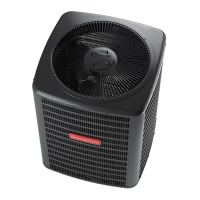How to check faulty transformer in Goodman Air Conditioner?
- KKevin OlsonAug 31, 2025
If your Goodman Air Conditioner has a faulty transformer, check the control circuit with a voltmeter.

How to check faulty transformer in Goodman Air Conditioner?
If your Goodman Air Conditioner has a faulty transformer, check the control circuit with a voltmeter.
How to test faulty thermostat in Goodman GSC13048 Air Conditioner?
If the thermostat is faulty in your Goodman Air Conditioner, test the continuity of the thermostat and wiring.
How to test open overload in Goodman Air Conditioner?
If your Goodman Air Conditioner has an open overload, test the continuity of overloads.
What to do if Goodman Air Conditioner has noncondensibles?
If your Goodman Air Conditioner has noncondensibles, recover the charge, evacuate, and recharge.
How to test shorted or broken wires in Goodman GSC13048?
If your Goodman Air Conditioner has shorted or broken wires, test the circuits with an ohmmeter.
How to fix loose connection in Goodman GSC13048?
If your Goodman Air Conditioner has a loose connection, inspect the connection and tighten it.
What to do if Goodman GSC13048 has overcharge of refrigerant?
If you have an overcharge of refrigerant in your Goodman Air Conditioner, recover part of the charge.
| SEER Rating | 13 |
|---|---|
| Compressor Type | Scroll |
| Refrigerant | R-410A |
| Operating Voltage | 208/230V |
| Phase | 1 |
| Sound Level | 76 dB |
| Cooling Capacity (BTU) | 48000 BTU |
Information regarding nitrogen/helium holding charge, component replacement use, and pre-2010 system usage.
Essential safety information covering high voltage, refrigerant handling, and general precautions.
Requirements for technicians, owner warranty, shipping inspection, and codes.
Details minimum airflow clearances and considerations for unit placement and rooftop installations.
Covers insulation, burial, connections, and recommended tubing sizes for refrigerant lines.
Guidelines for wiring, high voltage safety, conductor use, and hard start kit requirements.
Procedure and table for measuring system superheat in fixed orifice systems.
Steps for pressure testing, evacuation, and adding refrigerant to the system.
Instructions for adjusting system charge and reference to superheat/pressure charts.
A comprehensive guide listing symptoms, possible causes, and test methods for diagnosing issues.
Information and links to company websites and a statement on product quality.












